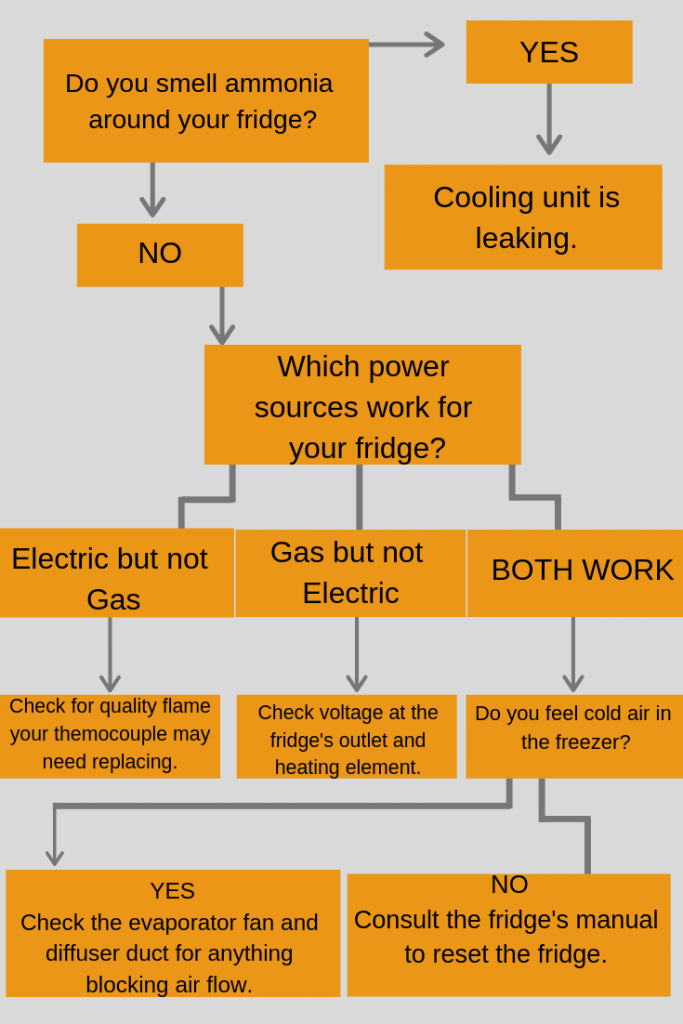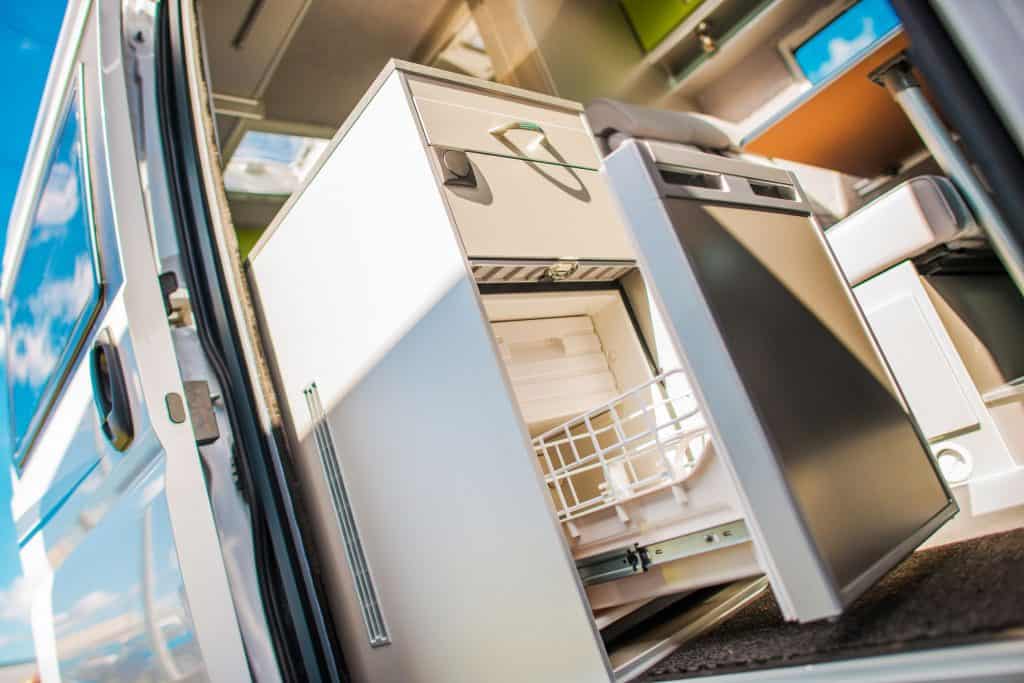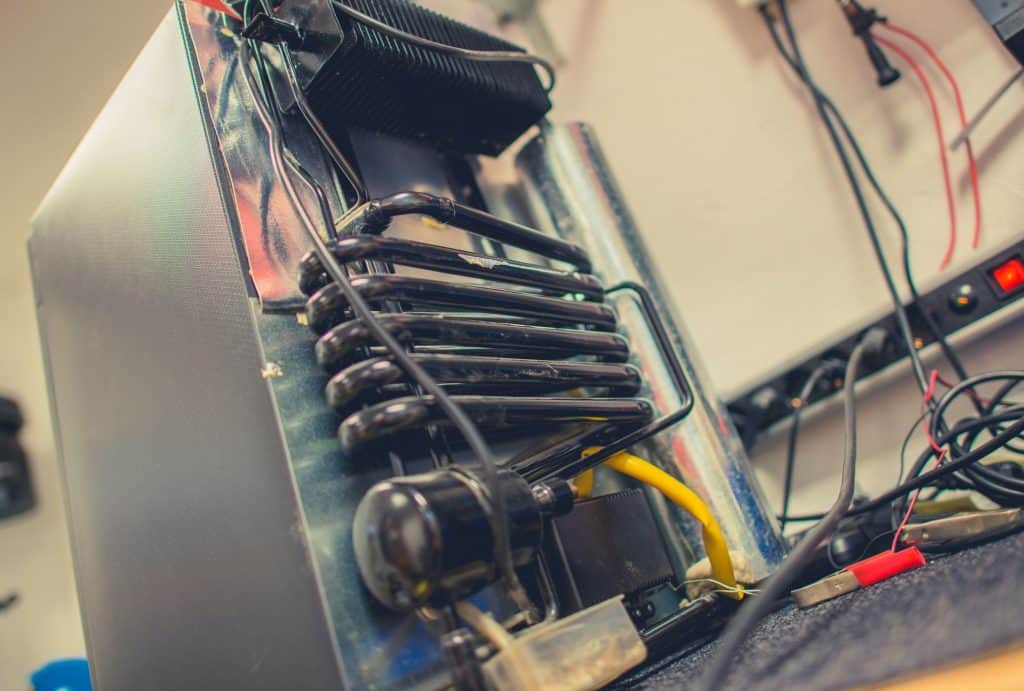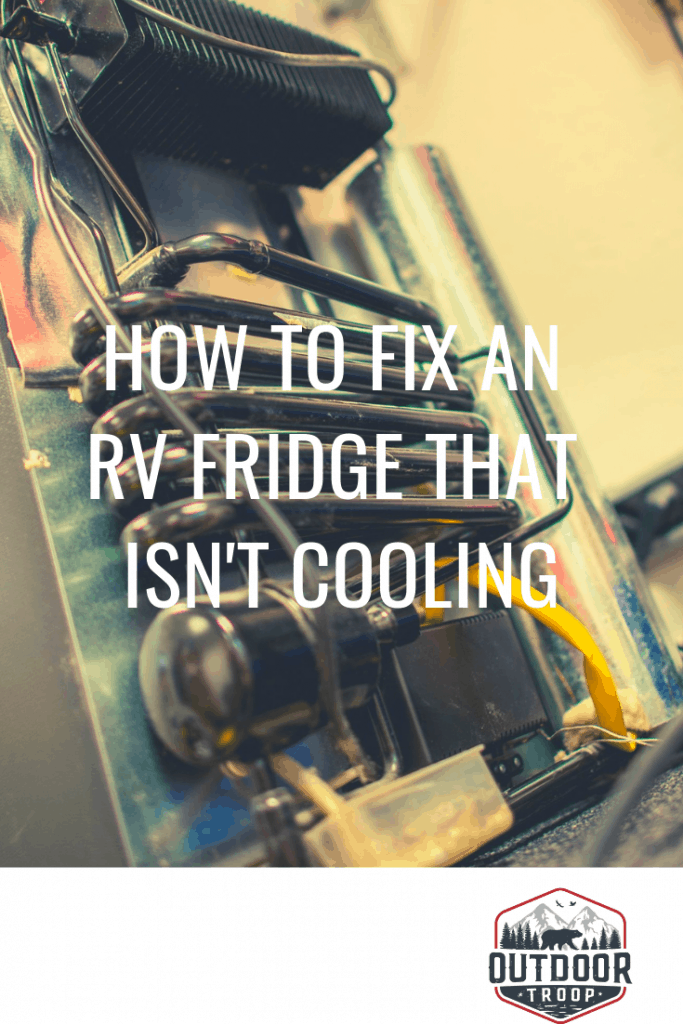While not instrumental to an RV trip having a faulty fridge is a huge loss for any long trip. But, replacing the RV’s fridge is going to get expensive fast. Luckily you can avoid replacing the whole fridge if you can identify the exact nature of your RV fridge’s problem. Then you’ll just have to replace one part instead of the whole fridge.
Easy right? Well maybe not but that’s why you’re reading this guide so let’s get to it.
Why is my RV Fridge Not Cooling?

Understanding Your Fridge

The first step is understanding how your fridge works. Don’t worry we won’t get to complicated here.
RV fridges are different than your refrigerator at home. There are many reasons for this, but the core difference comes from RV fridges using absorption refrigeration. This form of refrigeration doesn’t require any moving parts which is beneficial in an RV as the jostling from travel can often interfere with those moving elements.
The downside to this is that absorption refrigeration needs gravity to function. This means your fridge works best when it is level. If you run the fridge for a long time while it isn’t level, even by a few degrees, you run the risk of damaging the fridge.
Since there are less moving parts in an absorption refrigeration system they are generally easier to fix, so you’ll have a good chance of identifying your fridge’s issue.
One other difference is the fuel RV fridges run on. RV fridges run on gas generally and will have an option to switch from gas to electricity. The fridges fall into the categories of two-way and three-way fridges.
A two-way fridge is a fridge that will switch between LP gas and AC depending on which of the two is available. A three-way fridge has the options of AC, DC, and LP gas.
How to Fix an RV Fridge Not Cooling: Common Problems

Now comes the hard part. Replacing something that isn’t broken won’t change anything which means you need to figure out what is broken and then replace it. So begins the process of testing differing part of your fridge to identify the problem.
Check 1: Smell Around Your Fridge
We’ll get the big fish out of the way first.
If you smell Ammonia then you have a problem. Absorption type refrigerators use a combination of water, liquified ammonia, hydrogen gas, and sodium chlorate in the cooling coils to transfer heat. If you smell ammonia than the heat transferring coils have leaked this will require professional care.
You’ll want to talk to an RV dealer about what option is best for you, either replacing the coiling parts or buying a whole new fridge.
This is often the worst case scenario so it is best to check it out first and get the worst possibility out of the way.
Check 2: Does Your Fridge Work on One Type of Power But Not Another
Since your fridge is either a two-way or a three-way fridge you may find that your fridge will work when connected to one source but will not work when connected to another source.
To test this switch your fridge’s power mode between the options that you have available (electricity or propane tank) and test whether cooling happens. If cooling takes place on either of the power modes then your cooling unit is doing its job you instead have a problem with one of the power supplies.
For a video guide to help in the troubleshooting process Trailer Days has a No-Nonsense video to guide in the process around the power sources of the fridge.
RV Fridge Electrical Power Does Not Work
If your fridge works on propane gas but it does not work on 110v AC then there is something wrong with your electrical system.
First, check that you are getting the energy to your refrigerator. Check your circuit breakers and fuses. If all seems well there then you will want to test the outlet your fridge is being plugged into. Using a multimeter is the best option, you are looking for a reading between 110 and 120 volts, but if a multimeter isn’t available then you can plug a fan, lamp, or another small device into the plug to test if the appliance is getting energy.
If the voltage is present and all indicator lights are operational you’ll want to test the electric heating element next. Be warned. You will be dealing with dangerous voltages now, so if you don’t feel comfortable doing this or you don’t have to correct tools for the job, bring the problem to trained professionals.
To test the heating element use a multimeter. The wires powering the heating element come out of a tin case that rests below the cooling unit, and can be accessed from the back of the fridge. You may need remove the shielding for easier access. Only do this while the unit is unplugged.
After the multimeter is in position around the heating element reconnect and power up the fridge. If voltage is detected in only one wire but not the other, the element may be burned out.

A burnt out heating element will need replacing. Amazon has a great option right here.
If you don’t find any voltage at the element, the problem may be in the wiring or circuit board of the refrigerator circuit board. Testing this may require a qualified RV shop.
Gas Power Does Not Work
The first step here is to determine whether you have a good quality flame. This flame is also known as a pilot light. If the flame light goes out shortly after you have started it than your thermocouple may be at fault.
Thermocouples detect the heat from the flame and control the gas valve. They are known to go bad quite frequently so you may want to keep a spare on you should this be a common occurrence for your fridge. The thermocouple is attached to the main gas valve in the back of the refrigerator and connects to the gas burner with a tube.

If your looking for a Thermocouple to replace the faulty on in the fridge there is no need to struggle finding one Amazon has a great option for you. Just follow this link.
If the light doesn’t go on at all then check to make sure you have fuel and that the valve is on to release gas to the fridge. After confirming this you can vacuum the burner area up to the burner port. Remove the metal shielding around the burner and use a vacuum to clean the area around the flame.
There can often be rust or other forms of debris that will build up around the burner that blocks the burner unit. If needed you can push a thin wire into the burner orifice to unclog it. If doing this fixed the problem you should see a well-shaped flame that is mostly blue.
Neither Power Supply Works
If neither power supply works you can try the above tips to see if it is a combination of problems that have shut down both power supplies. But if you aren’t finding any success using the above tips than you will want to have a professional take a look at the fridge.
Both Power Supplies Work
If you test your power supplies and nothing seems to be amiss then your problem is somewhere else in the cooling system. See if further tips will help with the problems that you are facing otherwise some fridges have a small black reset button where the power supply switch is. If you have that on your fridge it may reset the fridge and get it cooling again.
12V DC Power on a 3-Way Fridge
If you are having issues with your DC power on a three way fridge you can test this similar to the AC power through confirming voltage at the DC’s extra electric heating element. You can test this with a multimeter just like with the AC heating element.
Check 3: Does the Freezer Compartment Work
Since absorption refrigeration uses gravity to spread their cooling agent the Freezer will get the cold air first and it will descend to the fridge portion of your unit. If you stick your hand in your freezer and find that it works but the fridge does not then there is an issue between the freezer and the fridge units.
The fan in the freezer is called an evaporator fan. This moves cold air from the freezer in to the main food compartment through a duct called a diffuser. You can find the diffuser in the back and center of the freezer. Listen for the evaporator fan and check to see if the diffuser duct is blocked with ice.
The evaporator fan turns on and off so you may need to listen for a little bit, and some fans will automatically turn off the fan if the door is open. If you can confirm the fan isn’t working than you can try unblocking the fan from whatever is inhibiting its movement. Or, you may need to replace the fan completely.
Check Out Our “How to” Page For More RV Maintenance Issues
Other Less Common RV Refrigerator Issues
When it comes to RV fridges the main issues are usually either a issue with one or both of the power supplies, a coil leak, or the freezer compartment frozen over, but if those aren’t your problem then hope isn’t lost there are a few other options for you attempt fixing your fridge yourself before calling on professional aid.
Ammonia Sediment Buildup
Problem:
When RVs are left without being run for a large amount of time, like over the colder months, there are several areas where resting devices or materials will cause future problems to arise.
For RVs this comes in the form of ammonia sediment build up. While this issue is a more frequent issue for older fridges sediment build up can still plague new RV fridges that rest for too long.
Evaporation refrigeration causes ammonia to constantly switch states between liquid and gas, through heating an cooling. When left alone the ammonia leaks out in liquid form and can drip down onto the cooling unit.
This buildup can then prevent the movement of ammonia in the future causing the cooling unit to stall. This cause you fridge to seem slightly cool at first and then grow warmer and warmer. At this point the fridge isn’t just not cooling your food it’s warming it.
Troubleshooting:
The first tip to help with this issue is to try to prevent the issue by preventing the fridge from being inactive for too long. You won’t need to activate the whole RV for this you just have to stop in every so often in those off months to turn on the gas and let the fridge run for a half hour or so.
The difficulty here is that unless prevented you are most likely only going to delay the inevitable here, so try to prevent sediment build up as much as you can. If build up occurs try unplugging the fridge and flipping it upside down. This is an old timers trick to try to get the sediment to travel away from the cooling unit.
This doesn’t always work and it is by no means a true fix to the problem, but it’s better to give it a try before deciding to replace your fridge entirely right?
Frozen Cooling Unit
Problem:
While a rare issue if you live in or frequent some incredibly cold areas you may run into this problem. Now to clarify when I say incredibly cold I’m talking about below -30 degrees Fahrenheit. So really cold.
At those intense temperatures your not the only thing that’s freezing your fridge can too. The liquid solution within the refrigeration cycle will freeze turning solid, which is the opposite of what an evaporation refrigerator wants. The solid mass of will prevent the fridge’s heat source from working. Which in turn is going to shut down the whole fridge.
Troubleshooting:
The best course of action here is to once again be preventative. Don’t leave your RV in freezing temperatures if at all avoidable. We are talking about extremely cold weather here so hopefully those temperatures aren’t constantly plaguing you and your RV.
If your fridge does get frozen though hope is not lost; take a lamp with a light bulb that is at least 60 watts and bring it close to the back of your fridge. This will gradually heat up the temperature and melt the solid mass that rests in the fridge. A space heater can also do this job.
Naturally, if worse comes to worst you food won’t spoil it’ll just freeze. Which depending on the food won’t be the worst thing to happen.

If your cooling unit is completely done for you can replace just that element of the fridge, but based on price it is often better to just get a new fridge. But if you love your old fridge Amazon has an option for a Norcold replacement cooling unit here.
Fridge Burner Failure
Problem:
Your RV fridge will have either two or three options to use. If you don’t understand when to use these power sources your fridge will generally switch automatically. The usually is not an issue unless you reach high altitudes in your travels.
When at high altitudes gas starts to act a little funny do to the thin nature of the air. One of the effects of being so high is excess strain on liquid propane, one of the most likely sources for your refrigerators gas fuel. If you don’t switch to electricity when in these high altitudes your fridge’s burner can burn out. This happens due to excess air that has made its way into your gas’s supply lines.
Troubleshooting:
When at high altitudes avoid using the gas setting on your refrigerator. If you have already done so and you find your burner failing you will want to reset your refrigerator and purge the propane cylinders. This will clear out the excess air help within the gas supply lines.
It is best to avoid this problem as constant amounts of excess air and the burning out of your fridges burners can damage them and force them to either get replaced if not needing the whole fridge to be replaced.
RV Fridge Still Not Cooling?
If you’ve test the above tips both common and uncommon problems then there are still a couple of options that you can try before giving up on your old cooling machine.
Check the Door Seals
The door should be tightly sealed when closed. If it is too easily opened, then cold air is escaping through the seal and will prevent the refrigerator from getting cold enough.
Keep Your RV Level
Evaporation refrigeration works best when the fridge is level. This can be a weird concept for some as at home there is no need to worry about your fridge being level, of course, it’s level your floors are level so your fridge is too.
So check to make sure that your camper is level. Even a slight angle can be a detriment. This all goes back to sediment building up. While the largest culprit is being left inactive for too long having your fridge at a bad angle can also increase the amount of sediment that is built up and can block the cooling functions of the fridge.
To prevent this you will need to adjust your camper’s position. Make sure you have the right tools, a measuring tape, ruler, level and go outside to test how even your trailer is. Check the angle of the RV and adjust it as necessary. If this becomes a habit of yours the fridge will thank you for it.
If you always keep the level of your RV in mind you’ll be able to prevent sediment build-up and will have a much happier and healthier fridge environment.
When driving it one not possibly and two not necessary to keep the fridge level. Since the concern here is the build-up of sediment the movement of the whole vehicle will prevent sediment from building up. So no need to worry about how level the fridge is in motion, just make sure it’s level when parked.
Proper Ventilation
Besides keeping the fridge level you will want to make sure that your fridge is being properly ventilated. This is necessary for the proper cooling functions involved in evaporation refrigeration.
Check for adequate gaps between the vent grills, and leave space above and behind the fridge. These grills are moving air which means they are prime collects of dust and dirt so it will help if you go in and clean them up every so often.
Keep your vents clean give them plenty of space to do their thing and your fridge should be able to do the rest by circulating air around your food and out of the fridge. Overstuffing the fridge or wedging a bunch of other materials around the fridge can cause strain on the fridge and lower the cooling ability that the fridge can provide.
Park in the Shade
Finally, park in the shade whenever you can. Refrigerators are affected by the outside temperature too so if you keep them cool they will do a better job at cooling your food. Parking in a cold environment isn’t always an option but when possible park with the fridge in the shade and it should boost how cool your food is kept.
Should You Drive With Your RV Propane on?
While many RVers drive with their propane on while driving to keep their fridge cold, it can be dangerous. Here’s why.
Unlike your at-home refrigerator, an RV fridge is an absorption fridge. This means it uses a propane heat source instead of having a compressor to keep it cold. This burns up water, hydrogen gas, and ammonia. The evaporation of these things creates condensation, which then cools your fridge.
Let’s now look at some reasons why driving with your propane on can be dangerous for you and your family.
- Can cause food poisoning: As previously discussed, your RV fridge is filled with fluid. Your RV needs to be on a level surface to work correctly. Otherwise, the fluid won’t be able to go where it needs to go. Even if your fridge seems cool when you reach your final location, this doesn’t mean it was the correct temperature your whole drive. The food may not have been cold for hours, only to be re-cooled once you reached level ground again.
- Propane leaks or gas poisoning: Although uncommon, propane leaks can occur. Whether you have to brake quickly and come to a sudden stop or, sadly, in an accident, this can cause the gas line to leak or break. Symptoms of gas poisoning include exhaustion, headache, vomiting, breathing problems, and more.
- Can cause fire and explosions: Since gas is highly flammable, a leak can lead to a fire or explosion on the RV. The tiniest spark in combination with gas, can cause your entire RV to go up in flames and put your family’s lives in danger.
To read more about driving with your propane on, click here!
The above possible issues are enough for me to leave off the propane while driving my travel trailer. It’s just not worth it to me personally. But there has to be a way to keep your fridge cold while you drive. Continue reading for some great tips on ensuring your food doesn’t go bad on you.
How to Keep Your RV Fridge Cold When Driving?
If you have decided not to drive with your propane to keep your RV refrigerator cold, how else can you prevent your food from spoiling?
Thankfully, there are several things you can do.
- Pre-cool your fridge: The night before your trip, level your RV in your driveway or the street in front of your house. Plug your RV into the house electricity and crank that temperature down. It’s best to put some water bottles or sodas in the fridge at this point so it has items to get cold and help retain the coldness of the refrigerator. Even better, put already cold drinks in it. The average running temperature of an RV fridge is between 34- and 43 degrees Fahrenheit. You want to set your fridge temp several degrees below this, although how low you go is at your discretion.
- Don’t open the door: Once the RV refrigerator is cool and you’ve packed all your food, let it return to its original temp. The temperature will have risen just by you opening the door and loading all your items in. Once the door is shut, DO NOT OPEN! Each time the door is opened, you let cool air out and warm air in. Instead, pack an ice chest with the items you’ll need while driving.
- Pack the fridge tight: You want to have a limited amount of open space in your RV fridge. Pack it as tightly as you can, possibly even putting some of your freezer items in as well (at least ones that are okay to be thawed out a bit). If you have any open nooks and crannies, see our next tip!
- Use Ice-Packs: When you have all your items in the fridge, I always fill in all the gaps with ice packs. You can either buy some online or simply freeze some water bottles and place them in the fridge. Plus, if you use water bottles, you can drink them once you get to your location, and they melt.
- Keep RV refrigerator in excellent condition: As with any other appliance in your home or on your RV, it is important to regularly maintain your fridge. Be sure to clean the inside and out, check the vent cover, wipe down the vent cover, and ensure the RV is level.
To read more on how to keep your RV fridge cold while driving without propane, click here!

Related Content
The minute you hit the road with your travel trailer, you have no power to the vehicle. After all, it’s not like you can plug into a campsite’s 120-volt socket when you’re on the go. If your trailer’s fridge is full of goodies that you don’t want to expire, you’ll need to retain the fridge’s coolness for as long as you can. How do you keep your travel trailer fridge cold when driving?
